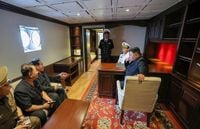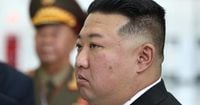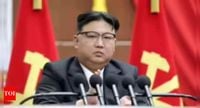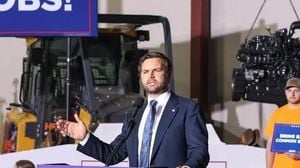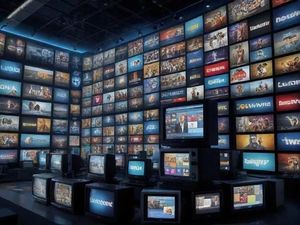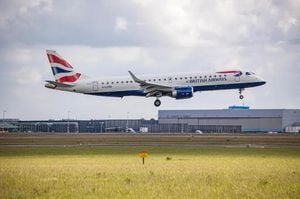As tensions on the Korean Peninsula reached a new high, North Korea once again captured the world’s attention by test-firing two newly developed surface-to-air missiles on August 23, 2025. The launch, personally overseen by North Korean leader Kim Jong-un, occurred amid the annual joint military exercises between the United States and South Korea—a period already fraught with suspicion and saber-rattling. According to reports from the Korean Central News Agency (KCNA) and corroborated by multiple international outlets, these new missiles are designed to target a range of aerial threats, including attack drones and cruise missiles, and are said to be based on what North Korean officials describe as “unique and special technology.”
The timing of the test was no accident. The Ulchi Freedom Shield 25 exercises, which began on August 18 and were scheduled to run through August 21, had already drawn the ire of Pyongyang. North Korea’s leadership has long viewed these drills as a direct threat, denouncing them as “the most hostile and confrontational stance toward Pyongyang.” On the very day the exercises kicked off, Kim Jong-un was seen touring the Choe Hyon-ho naval destroyer, where he delivered a fiery rebuke of the drills. He warned that the U.S.-South Korea exercises could “ignite a war” and called for a “rapid expansion of nuclearization,” as reported by KCNA and ABC News.
Kim’s presence at the missile launch was highly symbolic, especially as South Korean President Lee Jae Myung was preparing for his first summit with U.S. President Donald Trump, scheduled for August 25 in Washington, D.C. Just a day prior, Lee had met with Japanese Prime Minister Shigeru Ishiba, and both leaders reaffirmed their commitment to the complete denuclearization of the Korean Peninsula. In a joint statement, Seoul and Tokyo pledged closer coordination on North Korea policy—a move that surely did not go unnoticed in Pyongyang.
North Korea’s Missile General Bureau conducted the firings of the two new air defense missiles, aiming at different targets to assess their combat capability. The state-run KCNA was quick to highlight the “superior combat capability for fast response to various aerial targets such as attack drones and cruise missiles.” The agency claimed that the new weapon systems’ operation and reaction mode are “based on unique and special technology,” though, in typical North Korean fashion, few technical details or images were released. The secrecy surrounding the launch site and missile specifications only fueled international speculation about the true capabilities of these new systems.
Several high-ranking officials attended the missile test, including Jo Chun-ryong, secretary of the Central Committee; Kim Jong-sik, first deputy department director of the Central Committee; Air Chief Marshal Kim Kwang-hyok, commander of the Air Force of the Korean People's Army; and Kim Yong-hwan, president of the DPRK Academy of Defence Sciences. According to KCNA, Kim Jong-un used the occasion to set “important tasks” for the defense science sector, preparing for the upcoming Ninth Congress of the ruling Workers’ Party at the end of the year.
Observers and analysts were quick to interpret the missile tests as a calculated response to the ongoing allied exercises and the flurry of diplomatic activity. Hong Min, a senior researcher at the Korea Institute for National Unification, told Korea JoongAng Daily, “North Korea appears focused on showcasing improvements in its defensive and deterrent capabilities, rather than provoking with aggressive rhetoric or offensive weapon displays.” Indeed, Pyongyang seemed to keep the demonstration deliberately low-key, highlighting air defense systems rather than unveiling new offensive strike weapons. State media released only limited images, showing successful intercepts but withholding launch sites and technical details.
The missile test was not the only flashpoint on the peninsula that week. South Korea’s military reported that it had fired warning shots at approximately 30 North Korean troops who briefly crossed the heavily fortified Demilitarized Zone (DMZ) last week. North Korean state media quoted Army Lieutenant General Ko Jong Chol, who called the incident a “premeditated and deliberate provocation.” He warned, “This is a very serious prelude that would inevitably drive the situation in the southern border area, where a huge number of forces are stationed in confrontation with each other, to the uncontrollable phase.”
The rhetoric from both sides was as heated as ever. North Korean military officials, speaking to the state-run Rodong Sinmun, described the Ulchi Freedom Shield drills as destabilizing and reckless, accusing the United States and South Korea of “the destruction of balance of power in the region.” A spokesperson for the Korean People's Army went further, labeling the exercises as the work of “warmongers” and warning that they were pushing the Korean Peninsula into “extreme tension.”
Meanwhile, the U.S. State Department maintained that the joint drills were essential, stating their purpose was to “reaffirm the ironclad commitment between the U.S. and South Korea to defend their homelands.” South Korean President Lee Jae Myung, who took office in June 2025, has expressed hopes for warmer ties and pledged to build “military trust” with the North. However, Pyongyang has so far dismissed any possibility of improving relations, sticking to its hardline stance.
Images published by North Korean state media on August 24 showed Kim Jong-un meeting with military officials and missiles in mid-air, though, as noted by ABC News, the precise location of the tests remained undisclosed. The message, however, was unmistakable: North Korea remains determined to bolster its military capabilities and assert itself as a force to be reckoned with, particularly as its adversaries stage large-scale military maneuvers just across the border.
As the world watches the evolving situation, the missile tests serve as a stark reminder of the fragile balance on the Korean Peninsula. The interplay between military posturing, diplomatic summits, and the ever-present threat of escalation leaves little room for complacency. With the Ninth Congress of the Workers’ Party on the horizon and regional leaders locked in a complex dance of deterrence and diplomacy, the coming months promise to be anything but dull.
For now, North Korea’s latest missile tests have set the stage for another tense chapter in the peninsula’s long and troubled history, with all eyes on Pyongyang—and the world leaders seeking to contain its ambitions.
